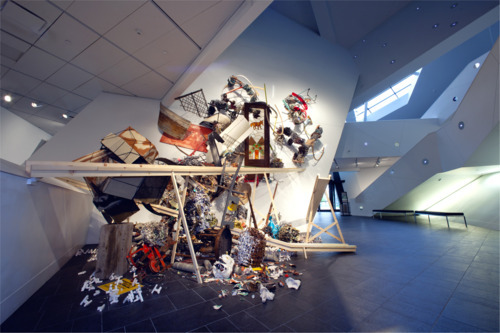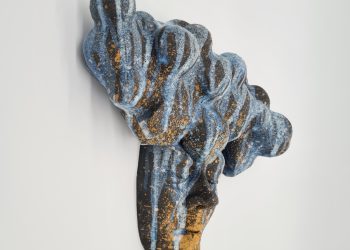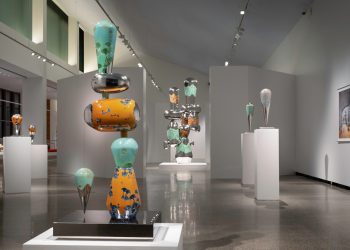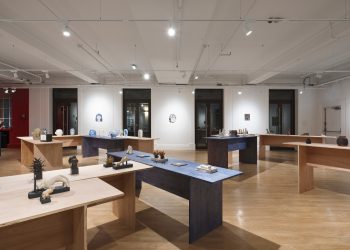
Linda Sormin, Mine (i hear him unclip me / blood runs cold), 2010–11. Glazed ceramic; souvenir kitsch. Photo by Jeff Wells.
Tell us about the work you exhibited at the Overthrown: Clay Without Limits exhibition.
This installation, Mine: i hear him unclip me, explores forms and structures of uncertainty height, and depth. I am curious about the sites and processes of mining. Two years ago in my installation “Rift” at the Middlesbrough Museum of Modern Art in the UK, I invited the curator, James Beighton, to crawl through a Plexiglas tube high in the air, wearing a mining hat and safety goggles. I asked him to “mine” the tunnels of the work by breaking open my hand-built porcelain pieces with a wooden hammer and chisel.
For this current installation in Denver, I scavenged and borrowed materials and objects from the Colorado School of Mines and Geological Museum in Golden, CO, and the Edgar Experimental Mines in Idaho Springs, CO. Boulder ReSource and thrift shops in the area were also sources of materials and forms, including a stained glass door picturing a coyote and flowers, and a large brown ear-less plastic bear head.
With the extraordinary technical assistance of my partner Seth Hisiger, I worked at my studio in Providence, RI for four months to create the ceramic components for the work. With extruded stoneware tubes and hand-pinched grids of red earthenware clay, we created linear drawings in space with fired and glazed ceramics. Because the installation was sited on a large slanting wall in the museum (it leans 110 degrees away from the viewer), we needed to build a mock wall at this exact angle in my studio. After Seth built this wall and developed a system of steel pipe to be mounted to it, we were able to test the structure by threading sections of the ceramic grids through the pipe. I’ve been interested in “skewering” ceramics (like meat!) in this way for a few years now. Final installation at the Denver Art Museum took 12 days. For the first three days, we worked closely with John Lupe’s outstanding installation team of eight, two motorized lifts and (for me at least) high levels of adrenaline. At first, I felt quite daunted by the large number of heavy, super-fragile objects we needed to mount to and balance on that wall – and I’m a little scared of heights. Maybe more than a little. While hand-pinching raw clay into the piece at 25 feet up, my knees went weak, and I had to sit down. So I worked that way in the gallery space – harnessed and clipped into a metal basket, legs dangling down.
Do you find it challenging to construct your works with objects from different places? You can also tell us what it’s like to work with recycled materials.
I am always grateful for the opportunity to work with objects from different places, with different histories of function and use in specific cultures. It’s a challenge that whets my appetite for making. I hope to tell stories with these things, to weave together abstract real-time narratives that invent or re-establish connections between objects, situations, people and places. Recycled objects are used objects with a past life. Their lack of innocence prevents them from being predictable to me, and their idiosyncrasies help to shape my installations. Their flaws resonate in the work, and in my imagination.

Linda Sormin, Mine (i hear him unclip me / blood runs cold), detail, 2010–11. Glazed ceramic; souvenir kitsch. Photo by Jeff Wells.
People described you as being extreme. How far do you agree with this?
In some ways, I think this could be true. On the other hand, I question if we can consider anyone working in a craft-based art profession to be extreme. In comparison to what? Is what I’d ask.
I imagine that being balanced and moderate would lead to a steadier, more peaceful way of life. I do often feel compelled to explore the edges of experiences, and feel that it is necessary to push boundaries and takes risks in order to comprehend the situations and behaviors of materials, things and people. This is the normal task of the artist, however – so it’s not extreme, just a choice – a research methodology perhaps. If I were less “extreme”, I might not get into the messes that I often find myself in. And then where would I be? These messes keep me alert and attentive to the work.

Where do you get inspiration for your works, do you have any hobbies?
I enjoy learning about objects and how they seem to behave in the world. From tools to clothing, domestic interiors to trash, digital technology to hands-on processes, I draw ideas and narratives from how people interact with things. Recently, I’ve been interested in the powerful machinery and risky methods used by people in so-called “manly” professions such as mining and marine work. When I visited the Edgar Experimental Mines in Idaho Springs, CO this past spring, I met miners who were studying outer space mining, as well as working with the military to develop approaches for underground operations. I’ve often used “mining” and ungrounding” as metaphors in writing and making – so it was humbling and enlightening to witness the real thing, and get to know the people actually working in these fields.
You tend to take adventurous tasks and use all kinds of materials. Do you think that one day you will be able to interfere with fashion to create pret-a-porter clothing from recycled materials?
There seems to be a growing number of people practicing apparel design in this way. I absolutely love clothes and am always excited by garments that offer material or social meaning from unexpected places. I would be thrilled to collaborate with a fashion designer or textile artist someday. Do you know anyone who’d be interested in working with someone like me who can’t sew a straight line?
Where can we find you and your works in the next future?
From August 4 – September 17 of this year, I will be in Norway making new work in the studios of the National Fine Art Academy in Bergen. My partner Seth Hisiger and I will be installing the work in the context of the China Collection at the West Norway Museum of Decorative Arts. From October 7-10 I’ll be giving a workshop at the Haystack Mountain School of Craft on Deer Isle, Maine. From October 27-29, I’ll be back in Bergen to speak at the Thing Tang Trash: Upcycling in Contemporary Ceramic Art Symposium.

Linda Sormin, Mine (i hear him unclip me / blood runs cold), detail,
The site looms above and veers past, willing me to compromise, to give ground. I roll and pinch the thing into place, I collect and lay offerings at its feet. This architecture melts and leans, hoarding objects in its folds. It lurches and dares you to approach, it tears cloth and flesh, it collapses with the brush of a hand.
Nothing is thrown away. This immigrant lives in fear of waste. Old yogurt is used to jumpstart the new batch. What is worth risking for things to get juicy, rare, ripe? What might be discovered on the verge of things going bad?
Linda Sormin is a Canadian sculptor based in Providence, Rhode Island. Through objects and site-specific installations, Sormin’s work explores issues of fragility and aggression, mobility and survival. Born in Bangkok, Sormin has a BA in English Literature and worked in community development for four years in Thailand and Lao PDR. She studied ceramics at Andrews University, Sheridan School of Crafts & Design (Grad 2001) and Alfred University (MFA 2003).
Sormin’s work has been exhibited nationally and internationally, most recently at the Denver Art Museum (Denver, USA), gl Holtegaard (Denmark), Vallauris (France), Middlesbrough (UK), Providence, Philadelphia and New Orleans. From 2003-06, Sormin taught ceramics at Emily Carr Institute in Vancouver, BC. For 5 years, she taught at the Rhode Island School of Design in Providence, RI, first as Assistant Professor (2006-09) then as Associate Professor (2009-11) and Head of Ceramics (2010-11).
Visit Linda Sormin’s website.
By Iunia Ratiu.
Published in Ceramics Now Magazine Issue 1.


















